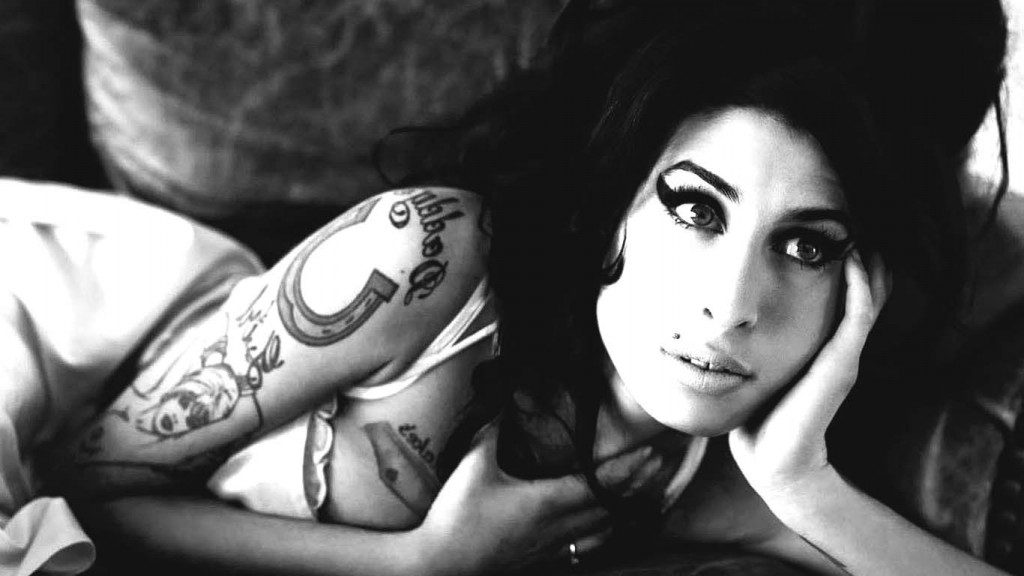There’s something about watching a beautiful woman self-destruct that we can’t turn away from. Asif Kapadia’s new documentary, Amy, that follows Amy Winehouse from age 14 until her death at 27 in 2011, had the chance to redeem her from the paparazzi-fueled spectacle of tragic victim martyred to the media and the music industry. But Kapadia seems, at least in part, to pick up where the media left off—cashing in on images of Amy’s wasted body, eyes rolling back in her skull, her smeared makeup and scratched-up face, her crumbling teeth, coke-lined nostrils, scenes of her desperately clinging to her husband, her father, her bodyguards, and managers. Her musical genius is almost an aside in the film, dashed off most convincingly in two short scenes in the beginning and a scene with Tony Bennett at the end.
I liked watching Amy. I loved hearing her voice again, catching rare but precious glimpses into the sharp-witted sparkling young woman she was before ravaged by addictions and celebrity. I’m also guilty of rubbernecking—what happens when a person finally submits to their darkness is fascinating to watch, and lets a viewer vicariously experience the relief of just giving up the fight. But there is a fascination with decay, a person dying before our eyes, the skeletal, the ghosted, that is covertly harmful. It’s the same fascination that uses emaciated models to sell dresses, and models posing dead-eyed and hollow-cheeked, legs askew, to sell designer handbags. Women’s death and suffering sells. It’s sickly sexy, and it’s dangerous.
 In her article for Pitchfork, Molly Beauchemin contrasts Amy with Montage of Heck, Brett Morgan’s biopic of Kurt Cobain that came out this January. She claims a comparison of the two films displays the sexist double standard of the music industry and the media, one in which a man’s musical brilliance is showcased with almost tangential mention about his struggles with addictions, whereas the narrative of the woman focuses on her downward spiral sensationalized by paparazzi and a public hungry to watch a celebrity unravel.
In her article for Pitchfork, Molly Beauchemin contrasts Amy with Montage of Heck, Brett Morgan’s biopic of Kurt Cobain that came out this January. She claims a comparison of the two films displays the sexist double standard of the music industry and the media, one in which a man’s musical brilliance is showcased with almost tangential mention about his struggles with addictions, whereas the narrative of the woman focuses on her downward spiral sensationalized by paparazzi and a public hungry to watch a celebrity unravel.
This double standard is well-precedented. Beauchemin cites coverage of other deaths of young women in the music industry—Janis Joplin, Billie Holliday, Whitney Houston—who were rendered as “substance-addled messes,” while reporters depicted the deaths of men like Jimi Hendrix, Kurt Cobain, and Keith Moon as flamboyant geniuses with some “sensual excesses.” Beauchemin writes that in Amy:
A slurry of ugly tabloid images fly across the screen and we see paparazzi preying upon her existential nadir—meanwhile, Montage of Heck posits a cache of neat magazine covers that offer obsequious, reverential coverage of a man whose drug addiction was portrayed as incidental to his supreme talent.
In an interview with the Guardian, Amy’s father, Mitchell Winehouse, deemed the film “horrible.” After a private viewing, he told the filmmakers, “You should be ashamed of yourselves. You had the opportunity to make a wonderful film and you’ve made this.” He also claimed the film was “both misleading and contains some basic untruths” about her family and management. Granted, Winehouse has copious reasons for discrediting the film. It portrays him as an absentee father who reenters his daughter’s life to ride on the coattails of her ascent to wealth and fame. Winehouse claims he was always trying to protect his daughter and work tirelessly for her best interest. It’s hard to know where the truth lies, probably, as it usually does, somewhere between the two narratives. But his point is well-taken—the film eschews Amy the artist for Amy the addict, and that’s a show we’ve already seen.
I wanted more footage of outstanding performances, improvisations and songs I hadn’t yet heard. The film does grant some access into the private archives of Amy as friend, daughter, lover, and wife. But we hardly learn anything about her early musical training, we rarely see her brilliant performances, triumphs, and successes. More outstanding performances and improvisations can be found in a cursory YouTube search. We do see some notebook scribbling, some shots of Amy recording in the studio, but this storyline is overshadowed by the much larger focus on Amy as victim.
can be found in a cursory YouTube search. We do see some notebook scribbling, some shots of Amy recording in the studio, but this storyline is overshadowed by the much larger focus on Amy as victim.
And she was a victim of so much—bulimia, depression, an absent father, an enabling mother, drug and alcohol addictions, co-dependent relationships, men in power over her—namely her father, her ex-husband, Blake Fielder-Civil, her manager, Raye Cosbert, all of whom, the film implies, pushed her past her breaking point for personal gain. As Tony Bennett points out towards the end of the film, she was also a victim of her youth. He said, “ Life teaches you how to live it if you live long enough.” Amy did not live long enough to learn that lesson, nor how to manage worldwide celebrity, Internet stardom, and all the baggage she brought with her.
There’s no doubt that Amy’s depression and addictions are part of her story—in fact they charged her music with the depth, urgency, and strength that made it so famous and well-loved. It gave her voice its distinctive haunt. Without her demons her lyrics and melodies may have joined the rest of the pop music at the time, music she herself criticized as shallow and unoriginal—one-offs about romantic love or lust or money. She made her music because she desperately needed it—it was her lifeline, therapy, medicine. In the film she dismissed medical treatment of her depression saying that she can pick up her guitar for an hour and feel better. But music can’t replace treatment, and while drugs and subsuming herself in her passion for Blake delivered temporary respite from her inner black, it wasn’t enough. The film doesn’t focus on her demons in service of her music, it dips into them on their own, brings us with her into the darkness she couldn’t see her way out of.
If this film had a thesis it would be: Amy, a brilliant talented artist, was led astray by men in power. She self-medicated with music but also with bulimia, drugs, and alcohol, and this killed her. I wish it had been: Amy was a brilliant and tortured artist. Lets explore her brilliance. Let’s watch her perform. And, like Montage of Heck, let’s portray her death quickly, with dignity. Perhaps this is a naive wish. I know sex and scandal sells. But we had plenty of that during her life. I wanted someone to come and raise her out of that in her death.
Kapadia failed to elevate Amy from that swirling mess of media filth, but Amy did succeed in exposing the paparazzi’s ruthlessness and carnivorous appetite and the way that can drive a person mad. Much of the film’s footage comes from the paparazzi who hounded her. Anthony Lane writes in the New Yorker, “You ask yourself if ‘Amy’ might not be half in league with the tabloid frenzy that it purports to scorn.” Towards the end of the film, Amy’s bodyguard, Andrew Morris, reports that the night of her death she was watching YouTube clips of herself. He reports that she said to him, “Man, I can sing.” And then, “If I could give it all back just to walk down the street with no hassles, I would.”
 If Kapadia fell short of restoring the focus on Amy’s life to its rightful place—on her music—he did so with the complicity of the free world. With his film, he gave us what we’ve proven we want—to tear down and watch fall what we’ve built up—like we’ve done with Britney Spears, Lindsay Lohan, and Miley Cyrus. Their dissolution sells magazines. But why?
If Kapadia fell short of restoring the focus on Amy’s life to its rightful place—on her music—he did so with the complicity of the free world. With his film, he gave us what we’ve proven we want—to tear down and watch fall what we’ve built up—like we’ve done with Britney Spears, Lindsay Lohan, and Miley Cyrus. Their dissolution sells magazines. But why?
Beauchemin believes that successful women upset a major cultural convention, one we are hungry to set right again. Beauchemin writes, “When women succeed as Winehouse did, we anticipate their downfall and pounce hard, relish the sillage of failure when we get a whiff… We martyr our women because we fear their greatness.”
One of the hardest things for me to see in the movie and in pictures online is how stripped down and ravaged her body became from her eating disorder—in some shots she is reminiscent of skeletal prisoners and torture victims. And we all watched, hungrily, and still she sang, was photographed, interviewed. This kind of intrigue is that it strips women of their power, of their very flesh—it gives the impression: ladies, if you want to be noticed, suffer like this, starve like this, bleed out in public like this, die like this. We’ll pay good money to watch.
***
Photo credits: featured image, image #2, image #3, image #4.





One response
my hesitant assessment: i’m not totally on board with this review. here’s why.
first, let me say the critique is excellently presented and, from the perspective of a longtime fan of Amy’s, probably valid.
the issue might be that i wasn’t a longtime fan of Amy’s. so the video of her singing Happy Birthday, of her performing solo with a guitar, of her vibrant and fierce personality and showmanship, were new. i feel in love with her work because of this film.
the rest of the critique i agree with, but i think the film did an excellent job of self-criticizing in that department– it made abundantly clear that Amy is dead because instead of personalizing her, the media pumped her for spectacle. even her own father did this. Amy was not some unsaveable tortured artist. we ate her alive and ignored her cries. i felt this message was piercing and effective and it definitely reached me. i felt sick.
the look of total childlike wonder on her face when, live, she watched Tony Bennett himself introduce her and grant her an award, was worth the price of admission for me. i saw someone who both WAS intuitively their art and cared deeply for it and its craftsmanship. and i’ll be diving deep into Amy’s catalog specifically because of the film.
i’m very sensitive to Amy’s already-fans who are sick of further depictions of the carnage. but i didn’t know the story at all. so when i read “Kapadia failed to elevate Amy from that swirling mess of media filth”, i can’t agree. for me this movie clearly and finally separated them, and Amy was shining like a star.
Click here to subscribe today and leave your comment.